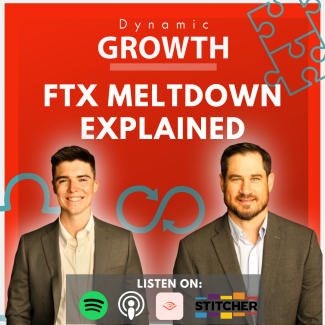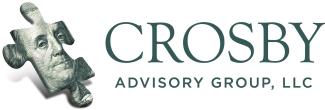
FTX meltdown explained
Everyone is talking about it, it’s all the buzz, and Derek gets to geek out on his favorite topic in this week’s podcast. Join us as we break down the Sam Bankman-Fried FTX journey, including the epic meltdown.
What exactly happened with FTX?
If you are wondering what FTX even is and how it ended up on all media outlets, you’re not alone! Here are some activities that led to the fall of Sam Bankman-Fried:
- Sam Bankman Freed is the CEO of FTX
- FTX was one of the largest crypto exchanges, valued at $32B
- FTX has experienced fast growth, which put Sam in close contact with many high-ranking professionals and celebrities
- FTX has made headlines quite a bit over the last few years – including:
- FTX offered BlockFi lines of credit during the Terra Luna downfall (listen to our previous podcast on Terra Luna here)
- There were rumors that FTX was looking to acquire Coinbase, arguably one of the top 5 largest crypto exchanges
- FTX purchased the home of the Miami heat, now known as FTX arena, and is a major sponsor at UC Berkeley field
- Athletes – including Tom Brady – had a stake in the company
- Celebrities – remember the FTX super bowl commercial with Larry David – were also bought in
Outside of the spotlight and notoriety that FTX was receiving, other things were happening with Sam’s business ventures. He also founded a trading firm in 2017 called Alameda Research, which managed $12B in assets for clients. Here’s when things go a little sideways:
- FTX created a token called FTX Token or FTT
- 30% of the profits from the FTX exchange were used to buy FTT to incentivize investors to buy the token. If FTX does well then FTT would go up in price.
- Sam took FTX / FTT tokens and gave them to Alameda Research
All was going “well” for Sam and his investors until earlier in this year when – like many other businesses – Alameda Research had a tough year and needed to come up with billions of dollars. So, what do they do? They borrow billions of dollars of client funds from the FTX exchange, and they use FTT as their collateral for the deal. Just a quick reminder, FTT is something made up of thin air and therefore not a very sound piece of loan collateral. At this point in time Alameda Research is having some hardships – but then its balance sheet was leaked and suddenly, even though they are a private company, everyone who wants to know can see they have a bunch of FTT and a huge loan backed by FTT collateral. In July 2021, Binance (the largest crypto exchange in the world) announced that it would be selling its stake as an early investor in FTX. They received $2.1B paid in cash and FTT. When Alameda Research’s balance sheet was leaked Binance made the decision to exit its FTT position. This put massive selling pressure on FTT because one of the largest holders was going to dump it onto the open market. So now Alameda Research can not pay the loan back to FTX because so much of their assets were tied up in the now worthless FTT. This caused a massive bank run in which FTX did not have enough money to cover all of the withdrawals.
Ultimately Sam is now trying to raise $650M to get his clients’ money back since his company was using that money to lend to Alameda Research and speculate on highly risky investments. The most likely scenario ends in a lengthy prison sentence for the FTX founder.
One final piece of advice for crypto investors. Remember new tokens tend to be guilty until proven innocent – assume there is risk involved. Bitcoin is the exception to that rule as it has proven itself over time as credible. Make sure you keep your Bitcoin in a hardware wallet – you can mitigate your risk with self-custody and a proven track record.
Four things you can do with free cash flow
Free cash flow is capital that is available to all claim holders (equity and debt) – after the company has reinvested in growth activities (think R&D, acquisitions, marketing). Free cash flow is essential because history shows us that the most long-term successful companies are extremely good at allocating free cash flow. There are four main things you can do with free cash flow: dividends, debt, stock repurchases, and accumulation.
Stock buy-back programs can be effective and when executed properly, can increase your stock earnings per share. Pro tip: we want companies that only buy back their own stock if the stock price is less than the company's intrinsic value(what it is worth). We’ve seen stock buy-backs go really well and really poorly – for example:
- Let’s look at Meta – they have spent roughly $45B on stock repurposes and while it has created demand, the average price per share paid was around $330/shared. So what? Well, Meta is now trading around $109/share. That’s a lot of money that could have been invested elsewhere; don’t you think?
- On the flip side, Apple has bought back about $90B of stock per year since 2012 and timed its purchases perfectly. They invested an average of $53/share over that time period and the stock is now valued at $144.
Another month, another CPI shock
The November inflation number (known as CPI) came out at a surprising 7.7% (down from 8.1%). This represented the largest decrease we’ve seen thus far this year, which proved to be positive news for the stock market. For now, we wait and see what happens in December.
Please note: This content is not a direct recommendation for investment. Investing involves risk including the potential loss of principal. Not all investments are suitable for all people. Crosby Advisory Group, LLC is a registered investment advisor in Ohio, Florida, and Texas.

